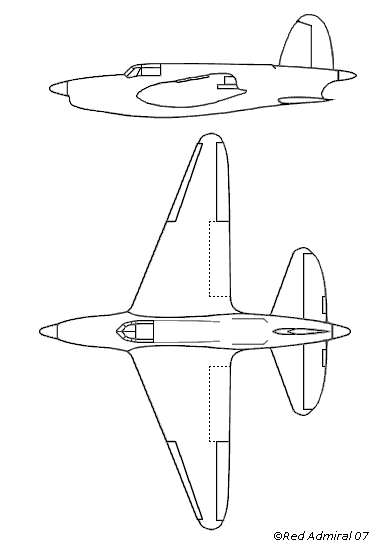FMA can offer the I.Ae 4S as offered to Brazil as a twin-engined fast torpedo bomber. Also carrier capable.

Aircraft Type or Name:
FMA I.Ae 4S
General Type:
Airplane = 1
Airship = 2
Orbiter = 3
1
Year of First Flight: 1934
Description
Carrier or Rough Field
Monoplane
Conventional Fuselage
A carrier-based bomber based on the Courier mailplane. Armament three 7.62mm fixed forward forward MG, 1,500lbs bombload or one 1500lb torpedo.
Characteristics:
Weight (maximum) 8,500 lbs
Weight (empty) 5,788 lbs
Length 30.75 ft
Wingspan 40 ft
Wing Area 406 sq ft
Sweep 2 degrees
Engines 2
FMA RR-14-2
Piston
700 hp
Crew 2
Typical cost $0.060 million in 1933
Total number procured 12
Performance:
Top Speed 218 kts = 251 mph
at 10,000 ft
Mach N/A
Operational Ceiling 23,000 ft
Range 424 nm = 488 miles
with 1,500 lbs payload
1,567 lbs released at halfway point
Climb 1,840 fpm
Cruise 174 kts = 200 mph
at 15,000 ft
Corner Speed 164 KIAS =
190 kts at 10,000 ft
Mach N/A
Turning Rate 20.9 deg/sec
Radius 1,756 ft
Internal Data:
Intake / Fan Diameter 8 ft
Bypass Ratio 100.2
Engine Weight 814 lbs
Overall Efficiency 22.5 percent
Structural Factor 1.00
Number of Wings 1
Number of Fuselages 1
Limiting Airspeed 200 kts
Wing Ultimate g Load 6.00 g
Wing Taper 0.1
Wing Thickness at Root 1 ft
Tail / Canard Factor 0.4
Number of Nacelles 2
Length 7.5 ft
Diameter 3 ft
Fullness 0.3
Fuselage Diameter 5 ft
Fuselage Fullness 0.3
Pressurized Volume 0 percent
Cargo Decks 1
Cleanness 59 percent
Unstreamlined section 2.3 sq ft
User equipment 700 lbs
IMPA and Spartan can offer the Vanquish II.

Aircraft Type or Name:
Spartan Sp-21A Vanquish II
General Type:
Airplane = 1
Airship = 2
Orbiter = 3
1
Year of First Flight: 1934
Description
Conventional Aircraft
Monoplane
Conventional Fuselage
A monoplane medium fast bomber armed with two dorsal 7.7mm and two wing root 7.7mm and one nose 7.7mm MG and a bombload of 4,000lbs
Characteristics:
Weight (maximum) 18,800 lbs
Weight (empty) 10,825 lbs
Length 48 ft
Wingspan 67 ft
Wing Area 600 sq ft
Sweep 3 degrees
Engines 2
Spartan 1000
Piston
1,000 hp
at 10,000 ft
Crew 4
Typical cost $0.046 million in 1934
Total number procured 200
Performance:
Top Speed 228 kts = 262 mph
at 15,000 ft
Mach N/A
Operational Ceiling 26,500 ft
Range 1,000 nm = 1,152 miles
with 4,165 lbs payload
4,517 lbs released at halfway point
Climb 1,078 fpm
Cruise 152 kts = 175 mph
at 15,000 ft
Corner Speed 225 KIAS =
325 kts at 23,000 ft
Mach N/A
Turning Rate 19.7 deg/sec
Radius 3,190 ft
Internal Data:
Intake / Fan Diameter 8.5 ft
Bypass Ratio 85.65
Engine Weight 1235 lbs
Overall Efficiency 22.5 percent
Structural Factor 0.98
Number of Wings 1
Number of Fuselages 1
Limiting Airspeed 250 kts
Wing Ultimate g Load 9.50 g
Wing Taper 0.3
Wing Thickness at Root 2.1 ft
Tail / Canard Factor 0.5
Number of Nacelles 2
Length 6 ft
Diameter 2.15 ft
Fullness 0.3
Fuselage Diameter 5.1 ft
Fuselage Fullness 0.4
Pressurized Volume 0 percent
Cargo Decks 1
Cleanness 60 percent
Unstreamlined section 1.8 sq ft
User equipment 1,200 lbs
Quoted
Originally posted by thesmilingassassin

Quoted
Originally posted by perdedor99Quoted
Originally posted by thesmilingassassin

Quoted
Anyway to get a range of 12,000 miles?



